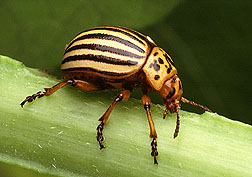This page has been archived and is being provided for reference purposes only. The page is no longer being updated, and therefore, links on the page may be invalid.
ARS Licenses Purple Bacteria to Battle Crop Pests
By Sharon DurhamDecember 13, 2007
A bacterium discovered by Agricultural Research Service (ARS) scientists that is toxic to Colorado potato beetle larvae also was found in preliminary studies to be toxic in varying degrees to gypsy moth, small hive beetle and tobacco hornworm. Now, ARS has licensed the technology to Marrone Organic Innovations, Inc., of Davis, Calif., and Natural Industries, Inc., of Houston, Texas.
ARS is the U.S. Department of Agriculture's chief scientific research agency.
Microbiologist Phyllis Martin, technician Ashaki D. Shropshire-Mitchell, entomologist Michael Blackburn, and molecular biologist Dawn Gundersen-Rindal, all at the ARS Invasive Insect Biocontrol and Behavior Laboratory in Beltsville, Md., found a new bacterial species called Chromobacterium subtsugae. The group then found that the bacterium displayed toxicity to immature Colorado potato beetles. Additional studies will be conducted to determine potential toxicity to non-target insects.
Soil rich in decomposed hemlock leaves and collected from the Catoctin Mountain region in central Maryland was the source of the C. subtsugae. The team isolated the microbe by suspending samples of forest soil in water and then plating it directly on growth medium. The unusual purple colonies were then tested in a project to develop a more efficient way to test for toxicity in Colorado potato beetle.
Other insects were also affected. While tobacco hornworm and gypsy moth weren't killed by the bacteria, their weights were drastically reduced. Weights of tobacco hornworms that were fed the bacteria-laced diet were 24 milligrams, compared to 119 milligrams for insects that didn't eat the bacteria. Gypsy moths that ate the bacteria weighed 40 percent less than gypsy moths that weren't exposed.
In previous studies conducted by Martin, C. subtsugae also was found to be toxic, in varying degrees, to western corn rootworm, southern corn rootworm, white flies, and diamondback moth. In July 2007, a patent was granted for use of the bacterium as a biocontrol agent against those pests.

